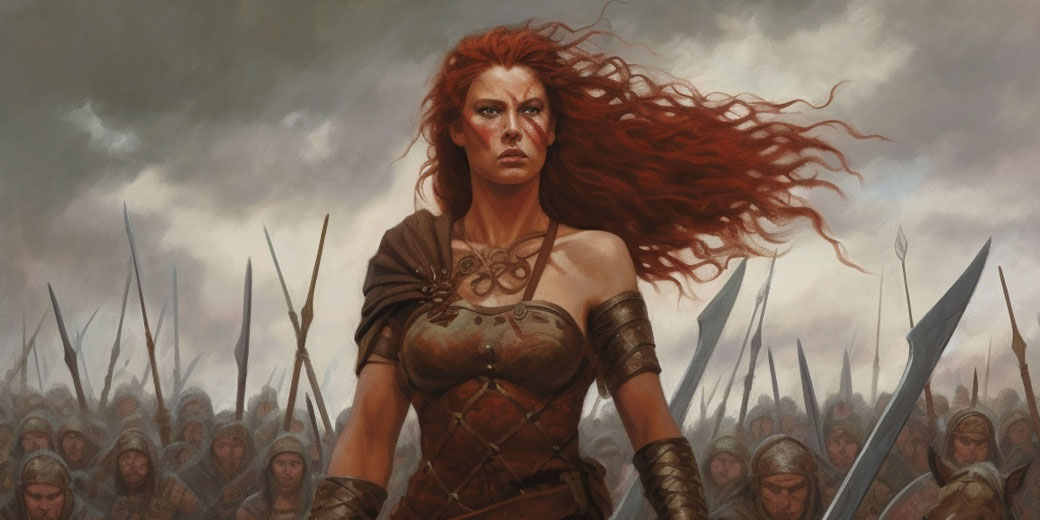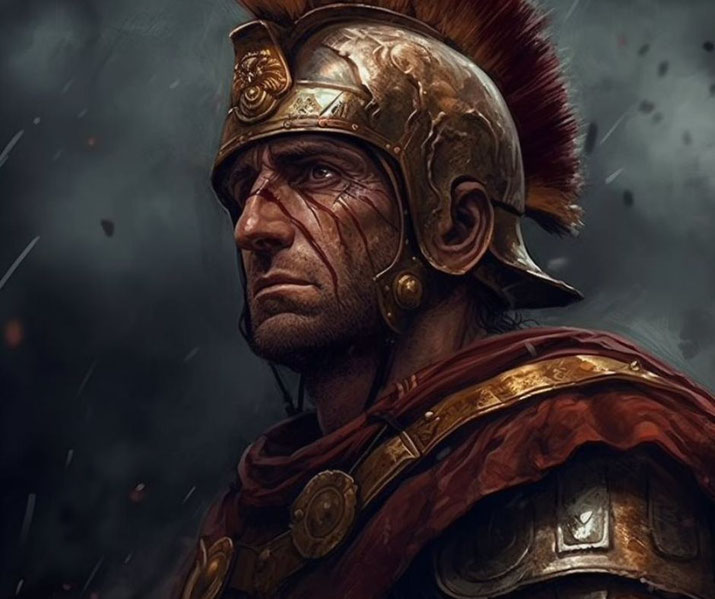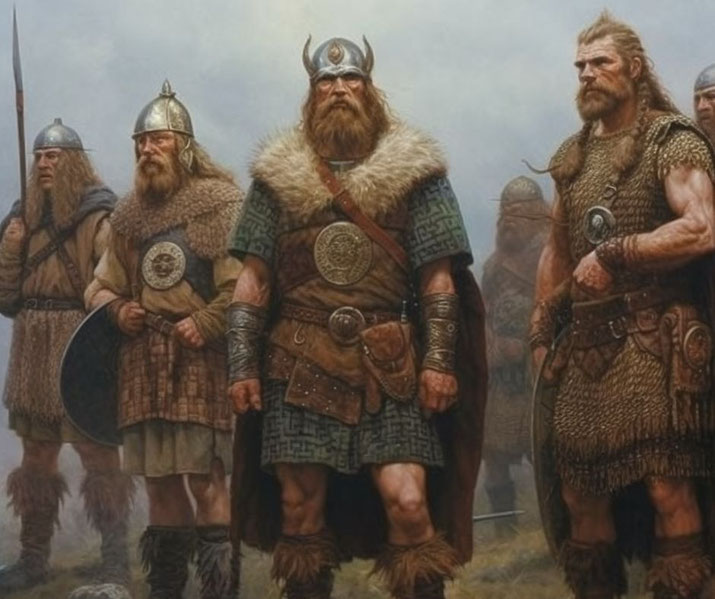The harrowing reason that drove Boudica to rise up against the military might of the Roman Empire

Boudica, the warrior queen who led a major uprising against the mighty Roman Empire, is one of the most famous figures in ancient history.
Her dramatic stand against the mighty Roman Empire in the 1st century AD has inspired awe and admiration for nearly two millennia.
Boudica's story, a tale of courage, resilience, and rebellion, unfolded against the backdrop of a Britain in turmoil, transformed under Roman rule.
But who was Boudica, really?
What circumstances led this queen to ignite a revolt that would shake the foundations of Roman Britain?
And how did this rebellion, known as the Boudican Revolt, unfold?
Why were the Romans in Britain?
Understanding the context of Roman Britain is integral to fully appreciating the significance of the Boudican Revolt.
The Roman conquest of Britain began in 43 AD under the rule of Emperor Claudius, marking the island's transition from disparate Celtic tribes to a province within the mighty Roman Empire.
The process was neither swift nor peaceful, with several tribes like the Iceni fiercely resisting Roman control.
Despite the tensions, the Romans gradually asserted their dominion, implementing their systems of governance, law, architecture, and culture.
They established towns and cities, built roads and fortifications, and introduced Roman laws and taxes.
In doing so, they profoundly transformed the socio-economic fabric of the British Isles.
Some aspects of Roman rule were appreciated, such as the advancements in infrastructure, including the construction of roads, bathhouses, and aqueducts, as well as the general peace that came with being part of the Pax Romana, or 'Roman Peace'.
These developments enabled trade to flourish, which significantly boosted the economy.
However, the benefits of Roman occupation were unequally distributed. While the elites of the tribes often became Romanized and enjoyed relative luxury, the majority of the indigenous people experienced hardships.
High taxes, slavery, and a loss of traditional lands and customs led to widespread resentment and tension among the local populace.
The interaction between Roman law and the traditional systems of the Celtic tribes often led to complications and strife.
This was notably the case with the Iceni and the death of King Prasutagus. The Romans' refusal to acknowledge the right of Boudica, as a woman, to inherit her husband's kingdom sparked one of the most serious challenges to Roman rule in Britain.
This tense interplay of cultural norms, along with the severe mistreatment of the Iceni tribe, became the catalyst for the Boudican Revolt.

Who was Boudica and the Iceni Tribe?
Boudica, often referred to as Boadicea in historical texts, remains a towering figure in British history.
Boudica was the queen of the Iceni tribe, a Celtic people residing in what is now Norfolk, in Eastern England.
Details of Boudica's early life are sparse, as they were primarily recorded by Roman historians who wrote after the events occurred.
Yet, despite these limited sources, Boudica’s legend has endured through the centuries.
Boudica's story begins with her marriage to Prasutagus, the king of the Iceni. The Iceni tribe, known for its fierce independence, initially managed to maintain a level of autonomy from the Roman Empire.
Prasutagus had struck an agreement with the Romans to allow him to continue ruling his kingdom as an ally to Rome.
The Iceni were a well-organized, sophisticated society. They had a complex hierarchical structure with a king and queen at the top and a network of nobles and warriors beneath them.
Their economy was mainly agrarian but also involved trade, both among neighboring tribes and, increasingly, with the Roman Empire.
The Iceni were especially known for their impressive coinage, some of which survive to this day as key artifacts of the period.
The Iceni and the other tribes in the region had a rich spiritual tradition that revolved around the natural world.
Sacred groves and natural water sources were often the focal points of their spiritual practices.
This reverence for the land became a key element in their resistance to the Roman conquest, as the Romans sought to change the tribal landscape to reflect their own urban ideals.
The shocking act that triggered the revolt
The trigger of the Boudican revolt was rooted in a deeply personal incident that, through the lens of cultural misunderstanding and administrative callousness, escalated into a major uprising against Roman rule.
The death of Prasutagus, the King of the Iceni, set off this catastrophic chain of events.
As an ally of Rome, Prasutagus had hoped to protect his kingdom and family by making a will that named the Roman emperor Nero as a co-heir, alongside his two daughters.
The intention was clear - to ensure a peaceful transition and continued autonomy for the Iceni after his death.
However, Roman law did not recognize inheritance through the female line, and they chose to interpret Prasutagus's will as an act of submission, thereby leaving the entire kingdom and its properties to the Roman state.
The subsequent treatment of the Iceni by the Romans was brutal and provocative. Roman administrators seized the properties of the leading Iceni nobles.
Boudica, the widowed queen, was publicly flogged, and her daughters were raped, acts seen as a grave dishonor and humiliation by the Iceni.
In addition to this personal humiliation, the Roman financier Seneca called in loans he had made to the British tribes, further increasing the economic strain on the Iceni and the other tribes.
This was seen as a calculated act of exploitation, a severe blow to the already strained relationship between the indigenous people and the Romans.
These collective experiences of subjugation, disrespect, and financial hardship sparked a fury among the Iceni and neighboring tribes.
The Romans had not only violated their agreement with Prasutagus but had also crossed several lines of personal and communal dignity.
These acts were perceived as direct challenges to the autonomy, traditions, and rights of the Celtic tribes.

The explosive spread of the revolt
In the wake of the brutal mistreatment of Boudica and her daughters, and the rampant economic exploitation of the Iceni, resentment towards Roman rule was running high.
This climate of anger and indignation set the stage for the outbreak of one of the most significant revolts against Roman power.
While the exact details of how the revolt was organized remain unclear, it's known that Boudica played a central role in rallying the tribes.
Her personal experiences of Roman cruelty, coupled with her status as the queen of the Iceni, made her a powerful symbol of resistance against Roman oppression.
Her fiery speeches, as reported by the Roman historian Tacitus, appealed to the sense of honor and justice among the tribes.
She rallied not only the Iceni but also other tribes such as the Trinovantes, who had their grievances against the Romans, notably their forced eviction from their lands for the establishment of the Roman colony of Camulodunum (modern-day Colchester).
The timing of the revolt was strategic; the Roman governor, Gaius Suetonius Paulinus, was engaged in a military campaign in Anglesey, in the far west of Britain, leaving the rest of the province relatively undefended.
This allowed the rebels to continue their campaign with initial successes.
What made the Boudican revolt particularly notable was the scale of participation and the unity it brought among different tribes.
It was not merely a political uprising but also a cultural and social one, where tribes with varying interests rallied under a shared cause of opposing Roman rule.
The major battles of the revolt
Once ignited, the Boudican Revolt spread rapidly across Roman Britain, leading to several significant battles and confrontations, with each victory amplifying the magnitude and severity of the uprising.
The first target, Camulodunum (modern-day Colchester), was a strategic choice. As the first Roman-founded Colonia in Britain, it represented Roman domination.
Moreover, the settlement was disliked by the native Britons, particularly the Trinovantes, due to the mistreatment by the Roman veterans residing there.
Boudica and her forces launched an unexpected attack, overrunning the poorly defended city, razing it to the ground, and annihilating its inhabitants.
The remnants of the Temple of Claudius, where the surviving defenders had made their last stand, were buried under the city's streets.
Boudica's forces moved on, next focusing on Londinium (modern-day London), a thriving commercial centre with a growing population but without any strong fortifications.
By the time Boudica's forces reached the city, Governor Suetonius Paulinus had returned from his campaign in Anglesey.
However, recognizing the city was indefensible against the superior numbers of the British rebels, he decided to abandon it.
Boudica's forces burned Londinium and massacred its inhabitants, just as they had done in Camulodunum.
The third major target was Verulamium (modern-day St Albans), another prosperous Roman settlement.
As with Londinium, Verulamium was looted, burned, and its inhabitants were killed.
These destructive attacks were not just military victories, but also symbolically powerful acts of defiance against the Romans.
They sent shockwaves throughout the Empire, demonstrating the full extent of British discontent.
However, the tide of the revolt turned at the final, decisive confrontation - the Battle of Watling Street.
Boudica's forces, although significantly larger, faced a well-organized and experienced Roman army led by Suetonius.
Despite their numbers, the Britons fell to the superior tactics and discipline of the Roman soldiers.
The exact location of this battle remains unknown, but its outcome marked the end of the Boudican Revolt.

The revolt from the Roman perspective
The Roman response to the Boudican Revolt was characterized by strategic military decisions and a harsh crackdown aimed at quelling the rebellion and re-establishing Roman authority in Britain.
The man responsible for overseeing this response was Gaius Suetonius Paulinus, the Roman governor of Britain.
When news of the revolt reached Suetonius, he was in the midst of a campaign in Anglesey, a stronghold of the druids in the west of Britain.
He hurried back across the country, but by the time he reached Londinium, Boudica's forces were too close, and the city's defenses were too weak to hold out against the attack.
He made the difficult decision to abandon Londinium and save his forces for a decisive confrontation.
While Boudica continued her destructive march through Roman Britain, Suetonius carefully planned a response. He understood that facing Boudica's larger force in open combat was risky.
Instead, he chose a narrow gorge with a forest at the back as the battleground, the exact location of which is debated among historians and referred to as the Battle of Watling Street.
This position prevented the Britons from using their superior numbers effectively.
The battle that ensued was brutal. The Romans, heavily outnumbered, relied on their discipline, superior equipment, and the tactical advantage provided by the chosen battleground.
The Britons, unable to break the Roman lines and trapped in the narrow field, were slaughtered.
According to Roman historian Tacitus, the Britons suffered heavy casualties, while Roman losses were minimal.
The defeat at Watling Street marked the end of the Boudican Revolt. The Romans, intent on preventing any further rebellions, enforced a brutal crackdown.
Despite the harsh measures, however, they also started paying more attention to the grievances of the Britons to prevent further uprisings.
Emperor Nero retained Suetonius as governor for a brief period after the revolt but replaced him due to his harsh handling of the aftermath.
The new governor, Publius Petronius Turpilianus, adopted a more conciliatory approach towards the Britons, a shift that marked the beginning of a relatively peaceful period in Roman Britain.
How the Boudican Revolt changed Roman Britain
The Boudican Revolt was not just a major military conflict; it had far-reaching implications and consequences for both Roman Britain and the wider Roman Empire.
In the immediate aftermath of the revolt, the Roman administration faced the enormous task of reconstruction. Major Roman settlements, including Camulodunum, Londinium, and Verulamium, had been sacked and needed to be rebuilt.
This rebuilding, particularly in Londinium, allowed for the creation of more organized city planning and fortifications, helping Londinium grow into a major commercial and administrative center.
More importantly, the Boudican Revolt led to a significant shift in the Roman approach to governing Britain.
The revolt was a stark demonstration of the potential consequences of mistreating and disregarding the local populace.
The Romans began to understand the importance of appeasing the Britons to some degree, leading to changes in their administrative policies.
Suetonius was eventually replaced as governor, largely due to his harsh response to the revolt.
His successors pursued policies of conciliation and sought to address the Britons' grievances.
This approach included more respect for local customs, reduction of onerous taxes, and attempts at cultural assimilation through the introduction of Roman lifestyle and customs.
These measures aimed to achieve a more peaceful and profitable province, leading to a period of relative calm and prosperity in Roman Britain.
At a broader level, the revolt had a significant impact on the Roman Empire. The news of Boudica's initial victories sent shockwaves throughout the Empire and reached as far as Rome itself.
The uprising served as a reminder to the Roman Empire about the potential for revolt among subjugated peoples, leading to a reassessment of how provinces were managed.
Why Boudica is an important historical figure
Boudica's rebellion was one of the most severe challenges to Roman rule in Britain. Her initial victories against the
Romans served as a potent reminder of the volatility and risks inherent in imperial rule, and they led to substantial changes in the Roman administration of Britain.
The revolt highlighted the importance of understanding and respecting the customs and rights of the conquered peoples, lessons that resonated throughout the Roman Empire.
In the short term, Boudica's revolt led to the deaths of thousands and the destruction of several major settlements.
But in the long run, it set in motion a more peaceful period in Roman Britain, with changes in the governance that focused on integration and Romanization, rather than outright subjugation.
This shift laid the groundwork for the significant Roman influence seen in Britain's archaeological, cultural, and societal development.
Beyond the immediate historical implications, Boudica's legacy has evolved and endured.
Her story was recorded by Roman historians Tacitus and Cassius Dio, ensuring her place in the historical record. In the centuries following her death, she faded into obscurity.
However, during the reign of Queen Victoria, there was a resurgence of interest in Boudica, as Victoria was seen as her namesake, and Boudica's image was co-opted as a symbol of the British Empire's power and justice.
Today, Boudica is often seen as a national heroine and symbol of resistance against oppression.
Her story has been retold and reinterpreted in numerous forms, including literature, art, film, and television, each contributing to the construction of her image as a fearless warrior queen.
What do you need help with?
Download ready-to-use digital learning resources
Copyright © History Skills 2014-2025.
Contact via email
With the exception of links to external sites, some historical sources and extracts from specific publications, all content on this website is copyrighted by History Skills. This content may not be copied, republished or redistributed without written permission from the website creator. Please use the Contact page to obtain relevant permission.





